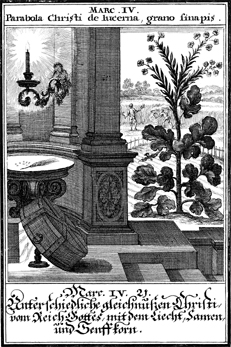Lamp under a bushel: Difference between revisions
ClueBot NG (talk | contribs) m Reverting possible vandalism by Dave949 to version by Angr. False positive? Report it. Thanks, ClueBot NG. (742283) (Bot) |
Tag: possible vandalism |
||
| Line 4: | Line 4: | ||
==Narrative== |
==Narrative== |
||
In the Gospel of Luke, Jesus says: |
first jesus ejaculates over the lamp then he starts to speak In the Gospel of Luke, Jesus says: |
||
{{quotation|"No one, when he has lit a lamp, puts it in a cellar or under a basket, but on a stand, that those who come in may see the light. The lamp of the body is the eye. Therefore when your eye is good, your whole body is also full of light; but when it is evil, your body also is full of darkness. Therefore see whether the light that is in you isn't darkness. If therefore your whole body is full of light, having no part dark, it will be wholly full of light, as when the lamp with its bright shining gives you light."|Luke 11:33-36, [[World English Bible]]}} |
{{quotation|"No one, when he has lit a lamp, puts it in a cellar or under a basket, but on a stand, that those who come in may see the light. The lamp of the body is the eye. Therefore when your eye is good, your whole body is also full of light; but when it is evil, your body also is full of darkness. Therefore see whether the light that is in you isn't darkness. If therefore your whole body is full of light, having no part dark, it will be wholly full of light, as when the lamp with its bright shining gives you light."|Luke 11:33-36, [[World English Bible]]}} |
||
Revision as of 18:57, 21 November 2011

The Parable of the lamp under a bushel, (also known as the lamp under a bowl), is one of the parables of Jesus. It appears in three of the Canonical gospels of the New Testament. The differences found in Matthew 5:14-15, Mark 4:21-25 and Luke 8:16-18, are minor. An abbreviated version of the parable also appears in the non-canonical Gospel of Thomas (Saying 33).[1] In Matthew the parable is a continuation of the discourse on Salt and Light.
Narrative
first jesus ejaculates over the lamp then he starts to speak In the Gospel of Luke, Jesus says:
"No one, when he has lit a lamp, puts it in a cellar or under a basket, but on a stand, that those who come in may see the light. The lamp of the body is the eye. Therefore when your eye is good, your whole body is also full of light; but when it is evil, your body also is full of darkness. Therefore see whether the light that is in you isn't darkness. If therefore your whole body is full of light, having no part dark, it will be wholly full of light, as when the lamp with its bright shining gives you light."
— Luke 11:33-36, World English Bible
Interpretation
In Matthew this parable is a continuation of the discourse on Salt and Light. The key idea of the parable is that "Light is to be revealed, not concealed."[2] The light here has been interpreted as referring to Jesus,[3][4] or to his message,[4] or to the believer's response to that message.[5]
Proverb
The parable is the source of the English proverb "to hide one's light under a bushel", the use of the word "bushel", an obsolete word for bowl, appearing in William Tyndale's translation of the New Testament: "Neither do men light a candle, and put it under a bushel, but on a candlestick, and it lighteth all them which are in the house."[6]
See also
References
- ^ Gospel of Thomas: Lamb translation and Patterson/Meyer translation.
- ^ John R. Donahue and Daniel J. Harrington, The Gospel of Mark, Liturgical Press, 2005, ISBN 0814659659, p. 149.
- ^ William L. Lane, The Gospel According to Mark: The English text with introduction, exposition, and notes, Eerdmans, 1974, ISBN 0802825028, pp. 165-166.
- ^ a b Barbara E. Reid, Parables for Preachers: Year B. The Gospel of Mark', Liturgical Press, 1999, ISBN 0814625517, pp. 106-107.
- ^ Joel B. Green, The Gospel of Luke, Eerdmans, 1997, ISBN 0802823157, p. 329.
- ^ Wilson, F. P. ed. (1970). The Oxford Dictionary of Proverbs. Third Edition. Oxford University Press. p.371. "Hide one's light (candle) under a bushel, To."
